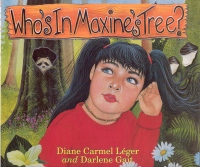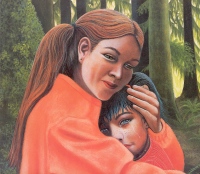| ________________
CM . . .
. Volume XII Number 13 . . . .March 3, 2006
excerpt:
Similar to Maxine’s Tree, published in 1990, the sequel, Who’s in Maxine’s Tree, follows Maxine, her family and friends on a hike in the Walbran Valley to the centre of the Carmanah Valley where Maxine’s favorite tree is located. On their hike, they cross bridges, climb along a waterfall and traverse part of the river by cable car. Much to their delight, Maxine and her cousin Eddie dip their feet into the freezing cold water of Vancouver Island. However, as they hike through the valley, Maxine is devastated to find that much of the valley has been clear-cut. Maxine worries about her favourite tree, the largest Sitka spruce in the valley. Two years before, she had claimed the tree as her own by writing “Maxine’s tree” on a plank of wood and placing it on the Sitka spruce in hopes that her beloved tree would not be cut down.
While the storyline and writing style of Who’s in Maxine’s Tree remain similar to the original Maxine’s Tree and the book displays a heart-felt deep-rooted concern for the environment, the illustrations are quite different than those in the first picture book. Illustrator Darlene Gait uses brightly coloured acrylic paints to create the sense of being deep in the rain forest of coastal British Columbia. Gait creates lush wildlife and foliage so that the reader can get a very good idea of what the rain forest looks like. However, while the figures are individualized and highly detailed, at times, they appear static and listless. This environmental picture book would work well in a lesson in the classroom concerning the rain forest, clear-cutting and the struggle in the early 1990’s to preserve first growth forest in the region. Today, as a result of the struggles of people in the early 1990’s, the Carmanah-Walbran region has become the oldest stand of protected forest on Vancouver Island. Recommended Genevičve M.Y. Valleau is currently enrolled in the Master’s of Arts program in Children’s Literature at the University of British Columbia.
To comment
on this title or this review, send mail to cm@umanitoba.ca.
Copyright © the Manitoba Library Association. Reproduction for personal
use is permitted only if this copyright notice is maintained. Any
other reproduction is prohibited without permission.
NEXT REVIEW |
TABLE OF CONTENTS FOR THIS ISSUE
- March 3, 2006.
AUTHORS |
TITLES |
MEDIA REVIEWS |
PROFILES |
BACK ISSUES |
SEARCH |
CMARCHIVE |
HOME |

 When they get to her tree, Maxine and Eddie meet a tree climber named Stephanie who is looking for the endangered seabird, the marbled murrelet or mamu, in Maxine’s tree. If there is a marbled murrelet nesting in the tree, because the bird is endangered, the tree will not be available to loggers. As Stephanie climbs Maxine’s tree looking for a mamu’s nest, Maxine and Eddie wait anxiously to see if one of the oldest trees in this valley will be cut down.
When they get to her tree, Maxine and Eddie meet a tree climber named Stephanie who is looking for the endangered seabird, the marbled murrelet or mamu, in Maxine’s tree. If there is a marbled murrelet nesting in the tree, because the bird is endangered, the tree will not be available to loggers. As Stephanie climbs Maxine’s tree looking for a mamu’s nest, Maxine and Eddie wait anxiously to see if one of the oldest trees in this valley will be cut down.